Space Travel in the Future
Unveiling the Future
NASA pulled the veil back from the future of space flight in September of 2011 with the release of its design for its new manned spacecraft and launch system. The spacecraft actually is not new, but a resurrected version of the Orion craft from the previously cancelled Constellation program. Orion, undergoing tests now, has been called Apollo on steroids. It is in some ways a larger version of the lunar spacecraft, but certainly a different vehicle.
Being built by Lockheed-Martin, the resurrected Orion, now called the Multipurpose Crew Vehicle, or MPCV, will have the same capability as Orion. Up to seven astronauts to low Earth orbit (LEO), four to the Moon, asteroids, or Mars. The new spacecraft will support four astronauts for as long as 900 days.
Like Apollo, it consists of a Command Module (CM) and a Service Module (SM). Both obviously are much larger than the moon craft. The MPCV’s CM is almost three times larger than Apollo, with two decks. The SM has considerably more capacity. Like Apollo’s SM, it contains an engine and propellant tanks, life support systems and consumables. But it also has space for considerable unpressurized cargo to LEO.
There is one major difference with the MPCV that allows it to have such a long flight time. Power is supplied by solar panels rather than fuel cells.
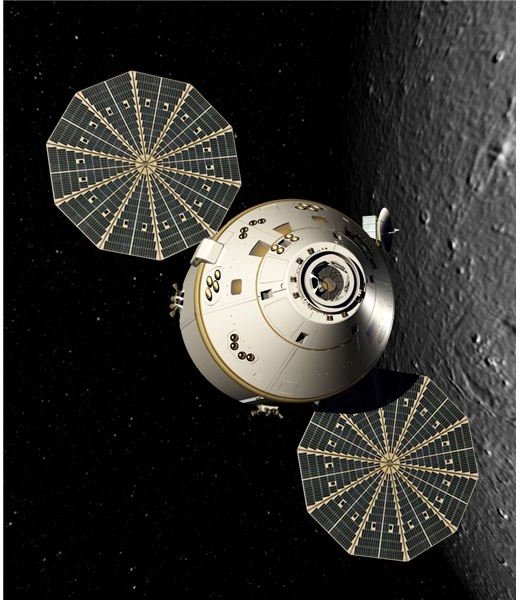
And while initial flights will land on water like Apollo, later flights will feature touchdowns on land with braking rockets and landing bags.
One other new feature—the spacecraft will be reusable.
A Chariot for Orion
To loft this bigger, heavier spacecraft, NASA needed a behemoth launch vehicle (LV). With Constellation gone, none of the commercial entries could do so. But, it seems NASA Administrator Charles Bolden may be descended from Mississippi riverboat gamblers. He was holding an ace in the hole. He had fulfilled Obama’s directive to give private firms the task of launching Americans and cargo into space in 2010 and this year (see below). The 2012 budget gave him the go-ahead to design and develop the giant LV needed for ORION.
The result is the Space Launch System, or SLS. This will be the most powerful rocket ever launched. Built from uprated parts of the Space Shuttle, it will have a liftoff thrust, with strap-on solid rocket Boosters (SRB) similar to the Shuttle’s, of more than eight million pounds. Later versions will have more than 10 million lbs of thrust. This power will give the SLS the ability to put 70 tons into low Earth orbit (LEO) with the initial design, and 130 tons with the later, two stage version.
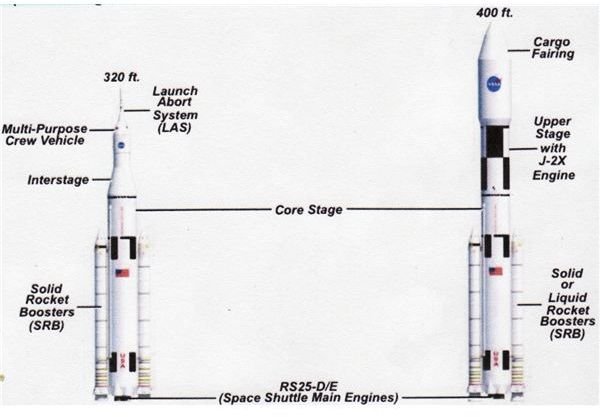
In the drawing above, the version on the left shows the Orion spacecraft atop the SLS. On the right is the so called ‘cargo version. This also is the LV that will be able to send Orion, and astronauts, back to the Moon, and beyond.
The first stage uses five uprated Shuttle main engines (the Shuttle had three) with LH2/LOX propellant. The SRBs are like the Shuttle’’s, but more powerful. On the smaller version, there is no need for a second stage, as the propellant combination provides a long burn and high exhaust velocity. In effect, the SLS is like the old ATLAS LV—a stage and 1/2 vehicle.
The large version has a second stage, again with LH2/LOX propellant. The engine is a new model of the Saturn V second and third stage engine with almost 300,000 lbs of thrust. It is restartable and so can put Orion into translunar, trans-asteroid or trans-Mars injection.
But the beyond the Moon missions would not be ‘all up’ like the lunar missions of the Saturn V. Instead, two or three different spacecraft would be launched into orbit by different LVs and hook up for escape from Earth. Bolden would soon have this covered as well.
America’s Manned Program in Limbo
The Space Shuttle ended its 30 year career in August of 2011. By Presidential decree, the Constellation program had been canceled, putting 40,000 people out of work in the midst of a recession and wasting the nine billion dollars already spent on it. With its cancellation, America had no manned space program to take its place anytime in the future.
Obama’s directive to turn development over to private enterprise, a direct result of the Augustine Panel report, which recommended such a move, while probably a good move in the long run, did not solve the short-term problem of providing astronauts with a ride to the ISS. For the duration, we would pay the Russians for round trip taxi service there. But, it turns out there’s a problem with this. The last resupply mission of the Progress resupply craft did not make it to the ISS because the upper stage of the LV failed. This is the LV that launches the Soyuz spacecraft to take new astro/cosmonauts to the ISS, and bring back those due to return. Fortunately the problem was solved before the ISS had to be abandoned. But Obama’s decree did not ensure the U.S. with future space presence. There were at the time no more plans for a return to the Moon, or a manned Mars mission, missions integral to the now defunct Constellation program.
NASA Administrator, Charles Bolden seemed to be trying to put the best spin he could on the situation. He pointed to the new budget being increased to keep the ISS operating until 2020 with, at the time, Americans riding Russian craft to get there. And, he touted that new propulsion systems and new propellants would be developed by private enterprise that in some distant future will allow us to populate the Solar System and mine the asteroids. He boasted about $50 million in contracts already let, using stimulus funds, to study developmental options.
But, as we’ve seen, it turned out Bolden had an ace in the hole.
Resurrection
Bolden began playing his hand in the summer of 2010 with the announcement that SpaceX Corp. had been chosen to develop and build an LV and spacecraft to supply the ISS. SpaceX’s Falcon LV and Dragon spacecraft easily passed their test to achieve orbit, and SpaceX was given the go ahead for at least 12 ISS resupply missions after two more tests. This satisfied the directive to commercialize space.
With Soyuz grounded for the time, NASA wants to speed up the Dragon schedule and have it dock with the ISS on its next flight, possibly this spring. However, Russia is balking at the proposal. Hmmm…could it be they don’t want to lose the dollars they get for their taxi service?
But, Bolden still hadn’t shown all his hand.
We’ve mentioned that the new program will include multiple launches with hookups in orbit. These will include in-space refueling stations and inflatable habitats. But the program doesn’t call for that many launches of the SLS. But the commercial LVs can lift the refueling stations and habitats to orbit, and more cheaply. NASA officials say the commercial systems will cost half that of a typical NASA launch.
And Falcon 9 is not the only one nearing service ready status. Orbital Sciences Corporation is close to a test flight of its Taurus II LV. This LV is designed specifically for cargo ferry duty. It can take an average of 13,000 lbs to the ISS. And of course there is the United Launch Alliance (ULA), an amalgam between Boeing and Lockheed-Martin, offering the myriad variations of their Atlas V and Delta III and IV LVs.
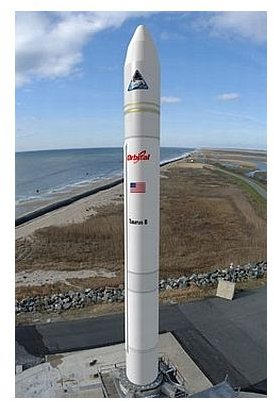
In fact, the Atlas V is being developed and manrated as the LV for a possible competitor to Dragon. Sierra Nevada Corp. is developing, under NASA auspices, a manned spacecraft to ferry up to seven astronauts to the ISS. Called “Dream Catcher’ this spacecraft is a winged lifting body that will land, like the Shuttle, on a runway.
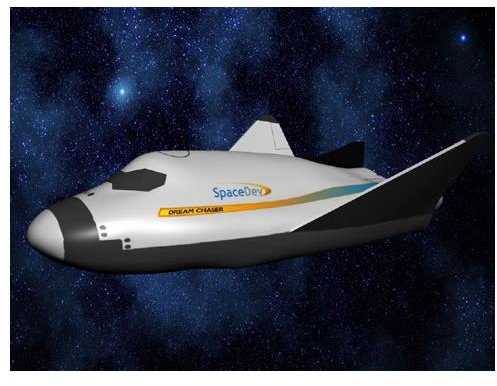
The New Vision
NASA Administrator Bolden offers a visionary scenario of thousands of humans roaming the Solar System in vehicles powered by exotic systems such as plasma engines, and even nuclear propulsion. One such system is known as Medusa. This rocket uses small nuclear bombs exploded periodically beneath what is effectively a sail to propel the ship.
Medusa is a variation on a nuclear rocket NASA seriously worked on in the mid-‘60s called Project Orion. Orion also used small nuclear bombs for propulsion, but they were exploded at the rear of the ship and pushed against a pusher plate. Work was halted because of passage of the Limited Nuclear Test Ban Treaty in 1963.
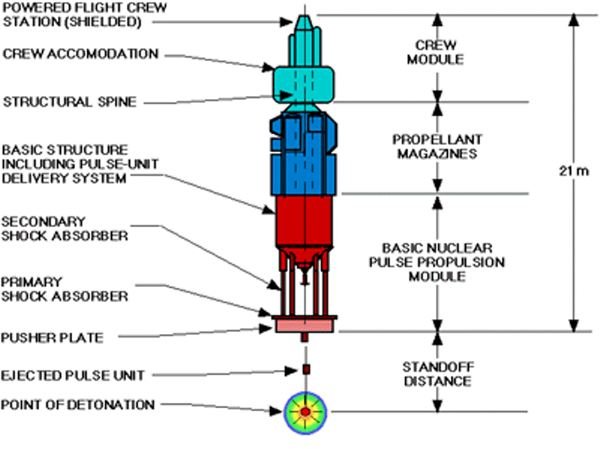
Both Medusa and Orion theoretically have the capability of achieving specific impulses (Isp) as high as 100,000. This could propel a ship to a good fraction of the speed of light. That would cut transit time to even the outer planets to a few weeks. It could take us to the nearer stars.
But these systems can be used only in space. Something must get them there. In the 1950s, a nuclear rocket was built and ground tested successfully many times. It was dubbed Project Nerva. Environmental outrage over possible (but unfounded) radiation contamination caused the project to be canceled.
Nerva could achieve an Isp of 850. The Space Shuttle’s main engines have an Isp of 452 in space. It produced thrust of only 250,000 lbs but it was a small test engine. The concept could easily have been upgraded to several million pounds. The engine was operated for as long as 90 minutes and could be stopped and restarted as many as 28 times.
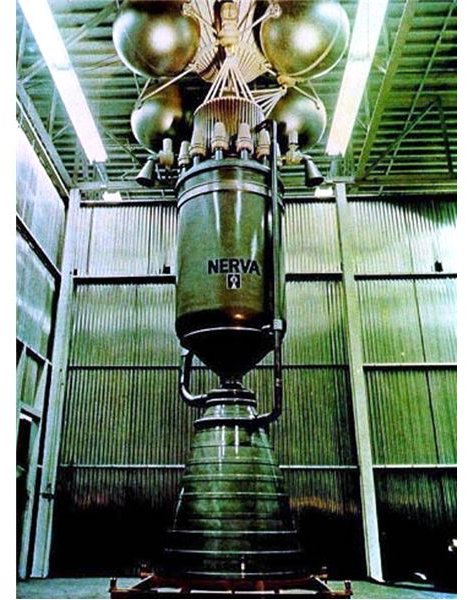
The new thrust (pun intended) of the SLS program does involve the use of some form of exotic propulsion system, as did Constellation. It most likely will be ion or nuclear plasma similar to the VASIMR system. Such propulsion could take us to Mars and the moons of the giant planets in weeks, or a few months.
Continuing the Legacy
There are, however, some critics of SLS. No one questions the design or goals. They question the schedule. The first flight of the resurrected Orion was not set until 2015, the first manned flight 2017. And then SLS is slated for just one flight a year. The critics (and I’m one on this matter) contend the schedule should be more aggressive.
Yes, more launches are costly. But we want to get back to the Moon and go on the Mars—before Russia or China or Japan does.
And, maybe we will. SLS with Orion is not the only system in the new stable. Falcon 9/Dragon, with the LV in a heavy lift version with strap-on SRBs, has the capability of sending Dragon to the Moon. And Dragon has the capability to make the trip with four astronauts.

It appears that we will continue the legacy of the nation that walked on the Moon.
Credits
All images: NASA
References
-
Bolden speech: http://www.nasa.gov/pdf/566100main_566100main_11%200701%20Final%20Bolden%20NPC%20.pdf
-
Falcon 9: brighthub.com Space Channel https://www.brighthub.com/science/space/articles/102242.aspx
-
Personal knowledge
-
SLS: NASA http://www.nasa.gov/pdf/588413main_SLS_Fun_Facts.pdf
Dream Chaser: NASA http://www.nasa.gov/offices/c3po/partners/sierranevada/index.html
Taurus LV: NASA http://www.nasa.gov/offices/c3po/partners/orbital/index.html
